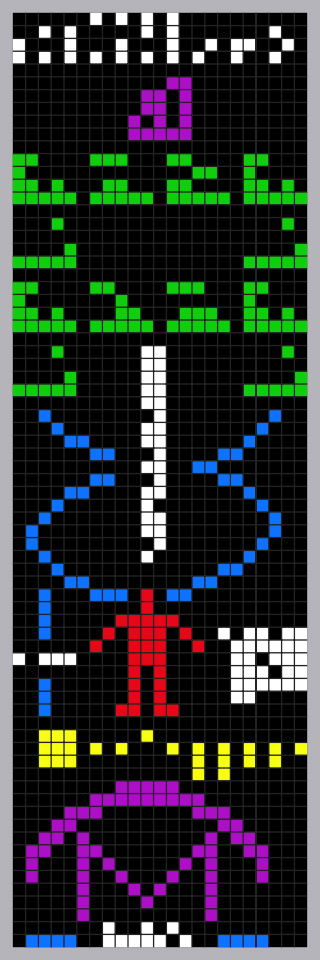Recently, a Facebook friend, Sascha Krader, whom I have never but as the following will reveal knows me pretty well, asked me this question:
I was talking with a friend today about Norway’s Svalbard seed vault. I had a fragment of a memory that some message beamed into space (i.e. Golden Record, Arecibo etc) had included a map to Svalbard — or they’d considered including one, then decided not to. But when I tried to look it up, to hammer out the details, I couldn’t find a thing. Does this sound familiar to you? I might have dreamed it, but if it’s real, it seems like it fits in the Venn diagram overlap between two of your interests — so I thought you might have heard it before.
I’m very interested in both, you’re right, and if the Svalbard seed vault was mentioned on The Golden Record, that would be way cool. I haven’t heard anything about that connection, though.
Looking on Wikipedia now:
“The Nordic Gene Bank (NGB) has, since 1984, stored backup Nordic plant germplasm via frozen seeds in an abandoned coal mine at Svalbard, over the years depositing more than 10,000 seed samples of more than 2,000 cultivars for 300 different species.”
and…
“…ceremonially laid “the first stone” on 19 June 2006.”
Voyager and The Voyager Interstellar Record were launched in 1977. I have a book about the making of the Record somewhere, but I can’t find it.[ref]Found it!

In any case, the dates tell me that the Record doesn’t contain info about the Vault.
I know there were very few messages directed into deep space, [ref]From Wikipedia
The Morse Message
In 1962, a radio message in Morse code was transmitted from Evpatoria Planetary Radar (EPR) and directed to planet Venus. The word “MIR” (Russian: Мир, it means both “peace” and “world”) was transmitted from the EPR on November 19, 1962, and the words “LENIN” (Russian: Ленин) and “SSSR” (Russian: СССР, acronym for the Soviet Union (Союз Советских Социалистических Республик)) on November 24, 1962, respectively. All three words were sent using the Morse code. In Russian, this letter is called Radio Message “MIR, LENIN, SSSR”. This message is the first radio broadcast for extraterrestrial civilizations in the history of mankind, it was also used as a test for the radar station (but was not used for measuring the distance to Venus because for distance measurements the EPR uses coherent waveform with frequency manipulation): The signal reflected from surface of Venus and was received 4 minutes 32.7 seconds (Nov 19) and 4 minutes 44.7 seconds (Nov 24) later.[/ref] (as opposed to radio and tv transmissions, which can’t travel very far)[ref]From BBC News Magazine,
Can our TV signals be picked up on other planets?
But ordinary television and radio broadcasts can also travel out of Earth’s atmosphere and through space, albeit quickly becoming mind-bogglingly diffuse and hard to pick up.
Space scientist Dr Chris Davis, of the Rutherford Appleton Laboratory, says it is possible that television and radio signals from Earth could be picked up on other planets, but it isn’t easy.
Some radiowaves, such as those of a short-wave frequency, bounce back off the ionosphere and are therefore poor candidates to be picked up in space. But waves like FM radio or television signals can pierce it and travel through the vacuum of space at the speed of light.
“There are two things that you would need to get a signal [to other planets] – firstly, it has to be able to leave our planet, secondly it would have to have as much power as possible,” says Dr Davis.
“As you go into space that power would dissipate. They would need more and more sensitive equipment to pick it up.”
“But television and radio broadcasts are omni-directional – albeit focused as much as possible towards the horizon – and that means a lot of diffusion.
Assuming the energy spread out equally in a sphere, and that the receiver on Gliese C was as big as the planned Square Kilometre Array of antennas on Earth, the television signals reaching the planet would be a billion, billion, billion times smaller than the original signal generated on Earth, says Dr Maggie Aderin, a space scientist at technology firm Astrium.
‘Detecting a signal like this with lots of background noise would be incredibly hard, but what they would look for is a pattern in the signals to show that they were not naturally occurring.'”[/ref] and someone did send something from Acrecibo, but I think that was before 1984, too. [ref]From Wikipedia
Arecibo Message

The Arecibo message was broadcast into space a single time via frequency modulated radio waves at a ceremony to mark the remodeling of the Arecibo radio telescope in Puerto Rico on 16 November 1974. The message was aimed at the current location of globular star cluster M13 some 25,000 light years away because M13 was a large and close collection of stars that was available in the sky at the time and place of the ceremony. The message consisted of 1,679 binary digits, approximately 210 bytes, transmitted at a frequency of 2,380 MHz and modulated by shifting the frequency by 10 Hz, with a power of 1,000 kW. The “ones” and”zeros” were transmitted by frequency shifting at the rate of 10 bits per second. The total broadcast was less than three minutes.[1][3]
The cardinality of 1,679 was chosen because it is a semiprime (the product of two prime numbers), to be arranged rectangularly as 73 rows by 23 columns. The alternative arrangement, 23 rows by 73 columns, produces jumbled nonsense (as do all other X/Y formats). The message forms the image shown on the right, or its inverse, when translated into graphics, characters and spaces.
Dr. Frank Drake, then at Cornell University and creator of the Drake equation, wrote the message with help from Carl Sagan, among others. The message consists of seven parts that encode the following (from the top down):
- The numbers one (1) to ten (10) (white)
- The formulas for the sugars and bases in the nucleotides of DNA (green)
- The number of nucleotides in DNA, and a graphic of the double helix structure of DNA (white & blue)
- A graphic figure of a human, the dimension (physical height) of an average man, and the human population of Earth (red, blue/white, & white respectively)
- A graphic of the Solar System indicating which of the planets the message is coming from (yellow)
- A graphic of the Arecibo radio telescope and the dimension (the physical diameter) of the transmitting antenna dish (purple, white, & blue)
Because it will take 25,000 years for the message to reach its intended destination (and an additional 25,000 years for any reply), the Arecibo message was more a demonstration of human technological achievement than a real attempt to enter into a conversation with extraterrestrials. In fact, the core of M13, to which the message was aimed, will no longer be in that location when the message arrives. However, as the proper motion of M13 is small, the message will still arrive near the center of the cluster. According to the Cornell News press release of November 12, 1999, the real purpose of the message was not to make contact but to demonstrate the capabilities of newly installed equipment.[/ref] And last year there was a big debate about deliberately sending messages into deep space. That’s when Stephen Hawking said it would be dangerous — inviting aliens to take over earth, etc.
So, perhaps you dreamed it? Or heard something on TV?
Thanks for the awesome question, Sascha.
Want to help A Life’s Work?
Donate Now!




